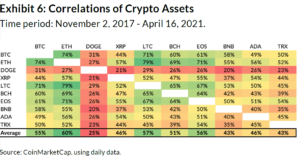How to Securely Order Cryptocurrencies: A Step-by-Step Guide for Beginners
How to Securely Order Cryptocurrencies: A Step-by-Step Guide for Beginners
Blog Article
The Future of Cryptocurrencies: Trends to Watch in the Coming Years
The appearance of Central Bank Digital Currencies (CBDCs) stands to redefine the assimilation of electronic possessions within conventional monetary systems, while enhanced regulative analysis may shape the operational landscape for cryptocurrencies. In addition, the advancement of decentralized financing (DeFi) and the expanding value of non-fungible symbols (NFTs) promise to change assumptions of possession and appraisal in an electronic economic situation.
Surge of Reserve Bank Digital Currencies
The appearance of Reserve bank Digital Currencies (CBDCs) stands for a significant shift in the monetary landscape as federal governments discover electronic alternatives to conventional fiat money. These state-backed digital money aim to improve the effectiveness of settlement systems, promote monetary incorporation, and supply a safe choice to personal cryptocurrencies. Unlike decentralized electronic currencies, CBDCs run under the auspices of reserve banks, ensuring governing oversight and stability.
A number of nations are proactively piloting or researching CBDCs, with significant instances including China's digital yuan and the European Reserve bank's digital euro effort. These efforts highlight a growing acknowledgment of the possible benefits of electronic money, such as faster deal speeds and reduced costs connected with cross-border repayments. CBDCs might offer as a device to battle immoral tasks by supplying greater openness in transactions.
As the fostering of CBDCs proceeds, they may reshape consumer actions and impact worldwide monetary characteristics. However, the shift to an electronic money framework presents obstacles, consisting of technical facilities, cybersecurity worries, and public trust fund. The rise of CBDCs signifies a crucial minute that can redefine the role of cash in a progressively electronic economy, requiring close observation by industry stakeholders and policymakers alike.
Raised Regulatory Analysis

Countries globally are taking varied strategies, from straight-out bans to regulative sandboxes that allow advancement while ensuring compliance. The European Union, as an example, is moving in the direction of thorough regulation with the Markets in copyright-Assets Policy (MiCA), intended at producing a unified method across member states. In the USA, firms like the SEC and CFTC are increasingly energetic in releasing standards and enforcement actions.
This regulatory setting is most likely to have considerable ramifications for market participants. Business operating in the copyright room might encounter stricter compliance needs, which could lead to raised operational prices. Clear guidelines could additionally promote better institutional financial investment, as companies seek to browse an extra specified lawful landscape. Eventually, the equilibrium in between innovation and guideline will certainly form the future of cryptocurrencies.
Evolution of DeFi Platforms
Decentralized Financing (DeFi) platforms have actually undergone significant change since their creation, improving the conventional monetary landscape - order cryptocurrencies. At first, these systems primarily concentrated on simple functions such as borrowing and borrowing, assisted in by wise contracts on blockchain networks. Nonetheless, the development of DeFi has actually broadened to include a wide variety of financial solutions, consisting of by-products trading, return farming, and automated market-making.
One of the most notable innovations is the introduction of Layer 2 services, which boost scalability and lower transaction prices, making DeFi a lot more easily accessible to a broader audience. Furthermore, cross-chain interoperability has actually come to be a crucial focus, enabling customers to transfer possessions effortlessly across different blockchain networks. This evolution promotes better liquidity and customer involvement.
In addition, the integration of sophisticated governance designs has empowered communities to join decision-making processes, advertising sustainability and development within the ecological community. As DeFi remains to mature, we can anticipate further enhancements in individual experience via boosted interfaces and security procedures, attending to issues that have actually formerly prevented mainstream adoption. Generally, the trajectory of DeFi platforms factors towards an extra comprehensive and effective monetary future, using options to standard financial systems.
Integration of NFTs in Financing
In the middle of the rapid evolution of the monetary landscape, the assimilation of Non-Fungible Tokens (NFTs) has arised as a transformative pressure. Traditionally connected with digital art and antiques, NFTs are now finding applications in numerous monetary fields, Read Full Article introducing innovative ways to stand for possession and value.
One considerable area of integration remains in realty, where NFTs can improve property deals. By tokenizing realty assets, buyers can delight in fractional possession, decreasing entry barriers and enhancing liquidity. order cryptocurrencies. Additionally, NFTs can make certain clear and immutable records of possession, improving count on genuine estate ventures
In the world of finance, NFTs are likewise being utilized for decentralized finance (DeFi) applications, allowing collateralization of properties. By using NFTs as collateral, debtors can access finances while maintaining possession of their electronic assets. This performance enhances the accessibility of monetary services and advertises a more inclusive economic environment.
Moreover, the integration of NFTs into traditional finance could transform the means copyright civil liberties are managed, providing designers with brand-new profits streams with smart contracts. On the whole, the integration of NFTs in financing signifies a change towards even more innovative, effective, and clear economic solutions, leading the means for future improvements.
Improvements in Blockchain Modern Technology

One substantial fad is the introduction of Layer 2 services, designed to boost scalability and transaction speeds, thus addressing the constraints of main blockchain networks. These solutions allow quicker processing of purchases, reducing charges and boosting performance, which is vital for mass adoption.
Moreover, interoperability between different blockchain networks is gaining traction. This development allows smooth data exchange and asset transfers across varied platforms, promoting a more linked and effective ecological community. Protocols that promote cross-chain interaction are essential for fostering partnership among decentralized applications (copyright) and enhancing customer experiences.
Additionally, developments in consensus mechanisms, such as proof-of-stake and handed over proof-of-stake, are adding to even more energy-efficient and protected blockchain operations. These advancements not Read Full Article just deal with environmental problems however also improve network resilience.
As blockchain modern technology continues to develop, its combination into different sectors, including finance, supply chain, and health care, will certainly redefine typical systems, leading the way for a decentralized future.
Verdict
Finally, the future of cryptocurrencies is identified by transformative fads that will shape the financial landscape. The introduction of Reserve bank Digital Currencies will boost the assimilation of electronic properties into typical economic systems. Simultaneously, regulatory structures will certainly progress, promoting institutional financial investment while making certain customer why not try these out security. In addition, the continual innovation of decentralized financing platforms and blockchain innovation, along with the integration of non-fungible tokens, will redefine possession and monetary transactions, promoting boosted adoption and advancement within the industry.
Report this page